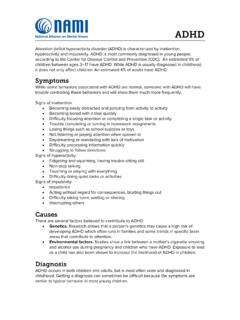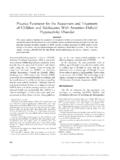Transcription of Neurodevelopmental Disorders - US EPA
1 Health | Neurodevelopmental Disorders Neurodevelopmental Disorders Neurodevelopmental Disorders are disabilities associated primarily with the functioning of the neurological system and brain. Examples of Neurodevelopmental Disorders in children include attention-deficit/hyperactivity disorder (ADHD), autism, learning disabilities, intellectual disability (also known as mental retardation), conduct Disorders , cerebral palsy, and impairments in vision and hearing. Children with Neurodevelopmental Disorders can experience difficulties with language and speech, motor skills, behavior, memory, learning, or other neurological functions. While the symptoms and behaviors of Neurodevelopmental disabilities often change or evolve as a child grows older, some disabilities are permanent.
2 Diagnosis and treatment of these Disorders can be difficult; treatment often involves a combination of professional therapy, pharmaceuticals, and home- and school-based programs. Based on parental responses to survey questions, approximately 15% of children in the United States ages 3 to 17 years were affected by Neurodevelopmental Disorders , including ADHD, learning disabilities, intellectual disability, cerebral palsy, autism, seizures, stuttering or stammering, moderate to profound hearing loss, blindness, and other developmental delays, in 2006 Among these conditions, ADHD and learning disabilities had the greatest prevalence. Many children affected by Neurodevelopmental Disorders have more than one of these conditions: for example, about 4% of children have both ADHD and a learning Some researchers have stated that the prevalence of certain Neurodevelopmental Disorders , specifically autism and ADHD, has been increasing over the last four Long- term trends in these conditions are difficult to detect with certainty, due to a lack of data to track prevalence over many years as well as changes in awareness and diagnostic criteria.
3 However, some detailed reviews of historical data have concluded that the actual prevalence of autism seems to be ,8-10 Surveys of educators and pediatricians have reported a rise in the number of children seen in classrooms and exam rooms with behavioral and learning Genetics can play an important role in many Neurodevelopmental Disorders , and some cases of certain conditions such as intellectual disability are associated with specific genes. However, most Neurodevelopmental Disorders have complex and multiple contributors rather than any one clear cause. These Disorders likely result from a combination of genetic, biological, psychosocial and environmental risk factors. A broad range of environmental risk factors may affect neurodevelopment, including (but not limited to) maternal use of alcohol, tobacco, or illicit drugs during pregnancy; lower socioeconomic status; preterm birth; low birthweight; the physical environment; and prenatal or childhood exposure to certain environmental Lead, methylmercury, and PCBs are widespread environmental contaminants associated with adverse effects on a child's developing brain and nervous system in multiple studies.
4 The National Toxicology Program (NTP) has concluded that childhood lead exposure is associated America's Children and the Environment | Third Edition, Updated October 2015 1. Neurodevelopmental Disorders | Health with reduced cognitive function, including lower intelligence quotient (IQ) and reduced academic The NTP has also concluded that childhood lead exposure is associated with attention-related behavioral problems (including inattention, hyperactivity, and diagnosed attention-deficit/hyperactivity disorder) and increased incidence of problem behaviors (including delinquent, criminal, or antisocial behavior).22. EPA has determined that methylmercury is known to have neurotoxic and developmental effects in Extreme cases of such effects were seen in people prenatally exposed during two high-dose mercury poisoning events in Japan and Iraq, who experienced severe adverse health effects such as cerebral palsy, mental retardation, deafness, and Prospective cohort studies have been conducted in island populations where frequent fish consumption leads to methylmercury exposure in pregnant women at levels much lower than in the poisoning incidents but much greater than those typically observed in the United States.
5 Results from such studies in New Zealand and the Faroe Islands suggest that increased prenatal mercury exposure due to maternal fish consumption was associated with adverse effects on intelligence and decreased functioning in the areas of language, attention, and These associations were not seen in initial results reported from a similar study in the Seychelles However, further studies in the Seychelles found associations between prenatal mercury exposure and some Neurodevelopmental deficits after researchers had accounted for the developmental benefits of fish More recent studies conducted in the United States have found associations between Neurodevelopmental effects and blood mercury levels within the range typical for women, after accounting for the beneficial effects of fish consumption during ,37,38.
6 Several studies of children who were prenatally exposed to elevated levels of polychlorinated biphenyls (PCBs) have suggested linkages between these contaminants and Neurodevelopmental effects, including lowered intelligence and behavioral deficits such as inattention and impulsive Studies have also reported associations between PCB. exposure and deficits in learning and ,45 Most of these studies found that the effects are associated with exposure in the womb resulting from the mother having eaten food contaminated with PCBs,46-51 although some studies have reported relationships between adverse effects and PCB exposure during infancy and ,51-53 Although there is some inconsistency in the epidemiological literature, several reviews of the literature have found that the overall evidence supports a concern for effects of PCBs on children's neurological.
7 54-58 The Agency for Toxic Substances and Disease Registry has determined that Substantial data suggest that PCBs play a role in neurobehavioral alterations observed in newborns and young children of women with PCB burdens near background levels. 59 In addition, adverse effects on intelligence and behavior have been found in children of women who were highly exposed to mixtures of PCBs, chlorinated dibenzofurans, and other pollutants prior to A wide variety of other environmental chemicals have been identified as potential concerns for childhood neurological development, but have not been as well studied for these effects as lead, mercury, and PCBs. Concerns for these additional chemicals are based on both laboratory 2 America's Children and the Environment | Third Edition, Updated October 2015.
8 Health | Neurodevelopmental Disorders animal studies and human epidemiological research; in most cases, the epidemiological studies are relatively new and the literature is just beginning to develop. Among the chemicals being studied for potential effects on childhood neurological development are organophosphate pesticides, polybrominated diphenyl ether flame retardants (PBDEs), phthalates, bisphenol A. (BPA), polycyclic aromatic hydrocarbons (PAHs), arsenic, and perchlorate. Exposure to all of these chemicals is widespread in the United States for both children and Organophosphate pesticides can interfere with the proper function of the nervous system when exposure is sufficiently Many children may have low capacity to detoxify organophosphate pesticides through age 7 In addition, recent studies have reported an association between prenatal organophosphate exposure and childhood ADHD in a community with relatively high exposures to organophosphate pesticides,67 as well as with exposures found within the general Other recent studies have described associations between prenatal organophosphate pesticide exposures and a variety of Neurodevelopmental deficits in childhood, including reduced IQ.
9 Perceptual reasoning, and Studies of certain PBDEs have found adverse effects on behavior, learning, and memory in laboratory A recent epidemiological study in New York City reported significant associations between children's prenatal exposure to PBDEs and reduced performance on IQ. tests and other tests of neurological development in 6-year-old Another study in the Netherlands reported significant associations between children's prenatal exposure to PBDEs and reduced performance on some Neurodevelopmental tests in 5- and 6-year-old children, while associations with improved performance were observed for other Two studies of a group of New York City children ages 4 to 9 years reported associations between prenatal exposure to certain phthalates and behavioral deficits, including effects on attention, conduct, and social ,78 Some of the behavioral deficits observed in these studies are similar to those commonly displayed in children with ADHD and conduct disorder.
10 Studies conducted in South Korea of children ages 8 to 11 years reported that children with higher levels of certain phthalate metabolites in their urine were more inattentive and hyperactive, displayed more symptoms of ADHD, and had lower IQ compared with those who had lower ,80 The exposure levels in these studies are comparable to typical exposures in the population. In 2008, the NTP concluded that there is some concern for effects of early-life (including prenatal) BPA exposure on brain development and behavior, based on findings of animal studies conducted at relatively low An epidemiological study conducted in Ohio reported an association between prenatal exposure to BPA and effects on children's behavior (increased hyperactivity and aggression) at age 2 Another study of prenatal BPA.
















